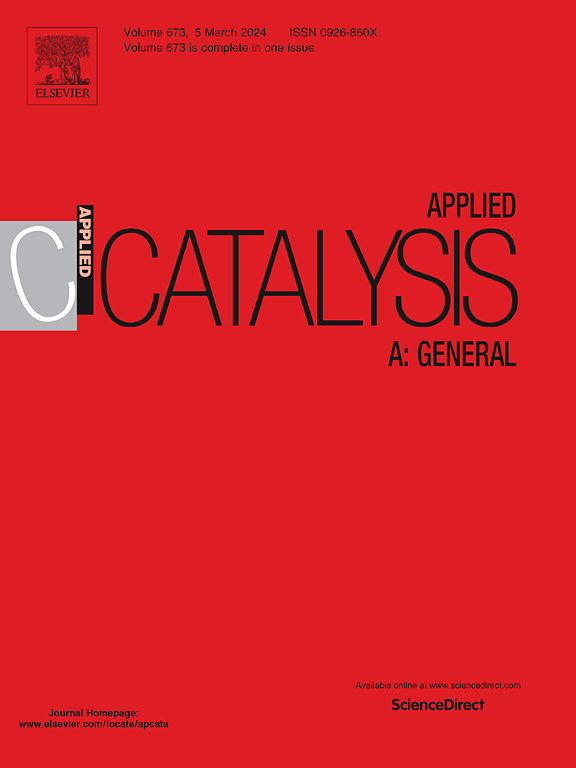通过缺陷和掺杂工程协同促进改性g-C3N4光催化产H2O2
IF 4.8
2区 化学
Q2 CHEMISTRY, PHYSICAL
引用次数: 0
摘要
采用简单的一锅直接煅烧方法,将钾掺杂剂和氮缺陷同时引入石墨氮化碳(g-C3N4,简称CN)中。三聚氰胺与KCl和草酰胺共煅烧产生了令人兴奋的积极影响,如减少分子间聚集,防止晶体过度生长和层间紧密堆积,延长层间堆积时间,有利于形成额外的孔隙。因此,所得到的材料为原始CN提供了优越的性能。当CPCN(0.5 mg mL−1)在可见光照射下存在时,在4 h内产生的H2O2浓度可达470.84 μM,是CN的近50倍。相应的H2O2产率为1569.45µmol g-1 h-1,明显高于文献报道的基于cn材料的结果。在模拟阳光照射下,其浓度和产率分别提高到1170.37 μM和3901.22µmol g-1 h-1。此外,CPCN在降解水中有机污染物(如罗丹明B染料和土环素抗生素)方面表现出优异的光催化性能。该研究不仅为高性能cn基光催化剂的合理设计开辟了一条有趣的途径,而且为光催化H2O2生成和有机污染物降解提供了一些有意义的见解。本文章由计算机程序翻译,如有差异,请以英文原文为准。
Synergistic promotion photocatalytic H2O2 production over modified g-C3N4 via defect and doping engineering
Potassium dopants and nitrogen defects are simultaneously introduced into graphitic carbon nitride (g-C3N4, abbreviated as CN) with a facile one-pot direct calcination strategy. The co-calcination of melamine with KCl and oxamide leads to exciting positive influence, such as reducing the intermolecular aggregation, preventing the excessive crystal growth and tight stacking between layers, extending the interlayer stacking time, and favoring the formation of additional pores. Therefore, the resulting materials deliver superior performance to the pristine CN. Especially, the optimal CPCN, which is fabricated with a molar ratio of 1: 1 for melamine to oxamide, exhibits exceptional photocatalytic behavior in H2O2 production, and the concentration of H2O2 produced can reach 470.84 μM within 4 h in the presence of CPCN (0.5 mg mL−1) irradiated by visible light, nearly 50 times that of CN. The corresponding H2O2 production rate is 1569.45 µmol g–1 h–1, significantly higher than the results over CN-based materials reported in literature. Moreover, the concentration and production rate can further separately increase to 1170.37 μM and 3901.22 µmol g–1 h–1 irradiated by the simulated sunlight. Also, CPCN depicts superior photocatalytic performance in the degradation of organic pollutants (such as rhodamine B dye and oxytetracycline antibiotic) in water to the control samples. This study not only develops an interesting avenue for the rational design of high-performance CN-based photocatalysts, but also offers some meaningful insights on photocatalytic H2O2 production and organic contaminant degradation.
求助全文
通过发布文献求助,成功后即可免费获取论文全文。
去求助
来源期刊

Applied Catalysis A: General
化学-环境科学
CiteScore
9.00
自引率
5.50%
发文量
415
审稿时长
24 days
期刊介绍:
Applied Catalysis A: General publishes original papers on all aspects of catalysis of basic and practical interest to chemical scientists in both industrial and academic fields, with an emphasis onnew understanding of catalysts and catalytic reactions, new catalytic materials, new techniques, and new processes, especially those that have potential practical implications.
Papers that report results of a thorough study or optimization of systems or processes that are well understood, widely studied, or minor variations of known ones are discouraged. Authors should include statements in a separate section "Justification for Publication" of how the manuscript fits the scope of the journal in the cover letter to the editors. Submissions without such justification will be rejected without review.
 求助内容:
求助内容: 应助结果提醒方式:
应助结果提醒方式:


